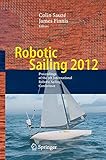Robotic Sailing 2012 [electronic resource] : Proceedings of the 5th International Robotic Sailing Conference / edited by Colin Sauz�e, James Finnis.
Contributor(s): Sauz�e, Colin [editor.] | Finnis, James [editor.] | SpringerLink (Online service).
Material type: BookPublisher: Berlin, Heidelberg : Springer Berlin Heidelberg : Imprint: Springer, 2013Description: X, 131 p. 79 illus. online resource.Content type: text Media type: computer Carrier type: online resourceISBN: 9783642330841.Subject(s): Engineering | Artificial intelligence | Computational intelligence | Engineering | Computational Intelligence | Artificial Intelligence (incl. Robotics)Additional physical formats: Printed edition:: No titleDDC classification: 006.3 Online resources: Click here to access online
BookPublisher: Berlin, Heidelberg : Springer Berlin Heidelberg : Imprint: Springer, 2013Description: X, 131 p. 79 illus. online resource.Content type: text Media type: computer Carrier type: online resourceISBN: 9783642330841.Subject(s): Engineering | Artificial intelligence | Computational intelligence | Engineering | Computational Intelligence | Artificial Intelligence (incl. Robotics)Additional physical formats: Printed edition:: No titleDDC classification: 006.3 Online resources: Click here to access online Part 1 Collision Avoidance and Route Planning -- Part 2 Extended Field Tests -- Part 3 Controller, Sensor and Rig Design.
Robotic sailing offers the potential of wind propelled vehicles which are sufficiently autonomous to remain at sea for months at a time. These could replace or augment existing oceanographic sampling systems, be used in border surveillance and security or offer a means of carbon neutral transportation. To achieve this represents a complex, multi-disciplinary challenge to boat designers and naval architects, systems/electrical engineers and computer scientists.  Since 2004 a series of competitions in the form of the Sailbot, World Robotic Sailing Championship and Microtransat competitions have sparked an explosion in the number of groups working on autonomous sailing robots. Despite this interest the longest distance sailed autonomously remains only a few hundred miles. Many of the challenges in building truly autonomous sailing robots still remain unsolved. These proceedings present the cutting edge of work in a variety of fields related to robotic sailing. They will be presented during the 5th International Robotic Sailing Conference, which is taking place as part of the 2012 World Robotic Sailing Championships.  .


There are no comments for this item.